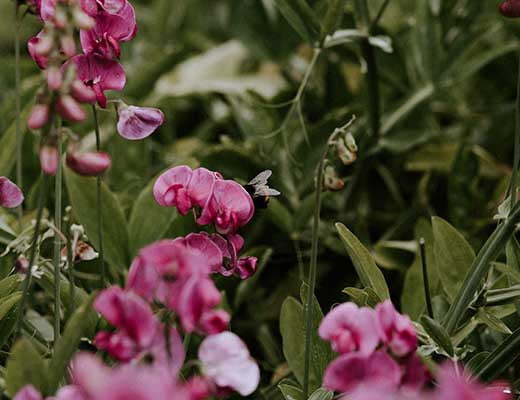
Sowing and Growing Sweet Peas
28 Feb 2019How to sow and grow Sweet Peas: once you’ve grown Sweet Peas, you’ll grow them forever, by garden designer Susan Begg.
Sweet peas are quite rightly one of our most popular and beloved flowers. A teepee swathed in loopy tendrils winding vigorously skywards, flowering its heart out as it goes, is one of Summer’s absolute joys. They’re so evocative, I’ve met many, many people who talk with great affection of parents, grandparents and other people dear to them who loved and grew sweet peas. Growing sweet peas seems to be passed down through generations, but don’t let this put you off if you’ve never grown them before. Growing sweet peas isn’t difficult and they’re incredibly rewarding, giving back ten-fold any effort, you put in. You can grow sweet peas in the smallest garden or a large container. As they grow vertically they don’t take up much space. Follow this guide and you’ll have sweetly perfumed flowers for your home all summer long:
Varieties to Grow
I’ve grown lots of different varieties over the years, I select on the basis of scent and colour. These are my absolute favourites.
Sweet Pea ‘Midnight’
‘Midnight’ is a gloriously, deep dark flower – like really good Pinot Noir, visibly pink and blue when the light shines through the transparent petals. It has a strong perfume, big generous flowers and long stems for cutting.
Sweet Pea ‘Wiltshire Ripple’
Long stems, good perfume and frilly, crimped petals. But really, the scoop on ‘Wiltshire Ripple’ is the ice cream appeal. The pale petals are deeply stained with swirls of juicy black currant ripple. A perfect vase-mate for the shady ‘Midnight.’
Sweet Pea ‘Mrs Collier’
A tall, pale, elegant grandiflora with ivory petals the colour of bridal satin, three per stem. Bred in Edinburgh by Dobie & Son in 1906 and named for ‘Mrs Collier’ who we can only imagine must’ve been a great beauty. Delicious scent.
Sweet Pea ‘Cupani’
As close to a ‘wild’ sweet pea as you’ll find in cultivation, ‘Cupani’ was discovered by Father Frances Cupani growing wild in Sicily in 1695. The seeds he sent to England marked the birth of the sweet pea in cultivation. Remarkably the original strain is still available. Proportionately smaller in every respect but the best fragrance of all sweet peas. A small vase of ‘Cupani’ will perfume an entire room.
Sweet Pea ‘Painted Lady’
The original bicolour ‘Painted Lady’ was an early progeny of ‘Cupani.’ The variety grown today is a reselection after the original dropped out of cultivation though the family resemblance remains in the upward flare of the top petal. Deep saturated Geisha pink upper petals saved from being overly sweet by the creamy wings. Heavenly scent.
Growing Sweet Peas
The optimal time to sow sweat peas will likely be fiercely debated until the last gardener hangs up his dibber. In my estimation, the best time to do anything in the garden is a combination of when I have time and when it will be successful. With regard to sweet peas, there are far too many competing priorities in autumn, not least the enormous pile of bulbs staring accusingly at me every day I don’t plant them. There are fewer jobs in late winter plus I can recall, perhaps conveniently, a number of trials that say this is the best time to sow*. So, that’s what I do. Anytime from 14th February to around the end of the first week in March.
How to sow Sweet Peas:
- I don’t soak the seeds and have never bothered with ‘nicking’ i.e. putting a little score on the seed and have always had a good rate of germination.
- Sow 2 or 3 seeds into a 1litre pot, or root trainer filled with John Innes No1 Potting Compost. If I only have regular multi-purpose compost then that’s what I use and again, I’ve not had any problems.
- Push each seed into the compost to the top of the joint on your index finger, roughly 2.5cm and ensure the seeds are well covered.
- Put them in a frost-free greenhouse to germinate or in a cool indoors location.
- If you’re germinating them in your home be sure to keep them somewhere cool or they’ll get tall, leggy and weak very quickly. Unless you live in a frost prone area it’s unlikely your sweet pea seedlings will suffer unduly from being outside during the day.
Growing on:
- Allow all the seedlings that germinate to grow on in the same pot, i.e. 2 to 3 per pot or root trainer.
- Pinch out the tips when each plant has three or four pairs of leaves. This encourages stronger, bushier growth.
Hardening Off and Planting Out Sweet Peas:
- Deciding when to plant sweet peas outside depends on the temperature and where you live. Many a gardener has paid for getting over-excited by a mild spell. In the South, you can expect to plant out from late-March to mid-April. Here in Central Scotland, I don’t like to chance it before mid-April to early-May.
- It’s important to harden plants off before planting. This means moving your plants outside in their pots for a period to toughen them up before planting. Move them outside during the day for around 7 days then bring them back in at night. Then leave them outside in their pots day and night for a further 7 days before planting.
- Choose a spot that gets a minimum of 6 hours of sunlight that is convenient to water. Once established sweet peas are very thirsty.
- How to plant out sweet peas begins with the proper prep. Prepare the soil and the support before planting. Dig in a barrow load of well-rotted manure. An area of about 50cm diameter is good for a teepee. Drive 5 bamboo canes, hazel or pea sticks into the soil, about 20cm deep, spaced regularly in a circle. Use twine to tie them together at the top. Then wind twine in a spiralling circle, from bottom to top, starting about 15cm from the base. Loop the twine securely around each upright as you go.
- Position each pot about 5-10cm from the support, two or three pots per upright is about right. You can put some on the inside and some on the outside of the teepee. Ease the plants out the pot and plant as it is without attempting to tease the plants apart. Sweet Peas hate root disturbance. The soil level should be the same level around the plant as it was in the pot.
- Water in well.

Maximizing and Reaping Your Harvest:
- Tie in the shoots once as they grow. They’ll do much better climbing the support than trailing on the ground. Once they’re tied to the frame, you should only need to tie in once a fortnight, using soft twine, or flexi tie.
- A good soak once a week is much better than little and often watering. I let the hose run on each teepee for a minute or so.
- I usually fill a watering can with high potash tomato feed and give this to each teepee once a fortnight.
- Cut flowers as often as they appear. Cutting stimulates new flower production. If you don’t manage to cut them before the flowers are spent, be sure to deadhead as many stems as you can. The Sweet Pea’s whole drive is to flower and set seed. At this point, its job is done, and the plant stops flowering, so you’re in competition with the plant to cut those lovely flowers and keep the plant flowering.



